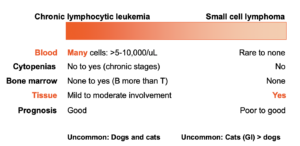Chronic lymphocytic leukemia and small cell lymphoma represent two ends of a spectrum of mature lymphoid neoplasms. They are essentially best distinguished by the main site of involvement. At one end, you have primary blood involvement (defined in human medicine as >5-10,000/uL clonal lymphocytosis for B cell neoplasms) or chronic lymphocytic leukemia. On the other end with lymphoma, the primary site of involvement is a peripheral or extramedullary lymphoid organ (spleen, lymph nodes, intestine). Then you have a range where there is overlap between the two extremes. This is because CLL can infiltrate extramedullary tissue and mimic lymphoma (example on aspirates or histologic sections). On the other hand, tumor cells from the lymphoma in the tissue can be seen in the circulation, particularly with some variants (e.g. indolent T zone lymphomas in dogs) and can also infiltrate the bone marrow, mimicking a chronic leukemia. Thus, the main distinction between these diagnoses is the site of involvement (blood or organs?).
In dogs, CLL is more common than small cell lymphoma. Cats suffer more from small cell lymphoma (particularly intestinal T cell lymphomas) than CLL. In horses, both diagnoses are rare, however we have seen a few cases of CLL and mature B cell lymphoma with a leukemic phase and they can be quite difficult to distinguish from each other. Ultimately, this distinction may be of academic interest only.

